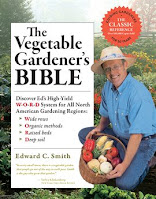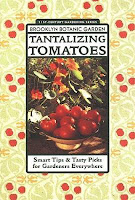Let the Library Help You Get Growing!
Some selected books on vegetable gardening from the Mercer County Library System collection:
General guides
These include several books for people with space to cultivate an in ground garden, for people with outdoor space like a deck or patio, and finally for people who have no access to outdoor space or who simply want to grow food indoors.
The following three books assume nothing and walk the novice gardener through every step of the process, but are also detailed enough to be of use to the more experienced gardener.
The Vegetable Gardeners Bible by Edward C. Smith is a comprehensive guide to all aspects of growing vegetables and herbs. It discusses planning your garden, the tools you will need, soil preparation, and includes an introduction to composting and an illustrated guide to dealing with disease and pests. A series of plant and herb portraits follows the extensive introductory material. These portraits cover guidelines on sowing and growing, including how to plant, watering and sunlight requirements, and suggested nutrients as well as some suggested varieties. These portraits range from one to several pages long and are illustrated with color photography.
Grow Vegetables by Alan Buckingham includes an introductory section concerning general topics such as soil mix, tools, harvesting and storing your crop. It then goes on to discuss some eighty different vegetables and herbs organized into categories such as root and stem vegetables, and fruiting vegetables. The discussion includes information on when and where to plant, routine care and possible problems. It also has a vegetable year planner, taking the garden from beginning preparation in midwinter through harvesting the last of the winter vegetables in early winter. It is extensively illustrated with color photographs.
Burpee - The Complete Vegetable and Herb Gardener - like the other books in this section, this is a comprehensive look at growing herbs and vegetables, from soil preparation to harvesting. It also includes abundant color photography. It is the most encyclopedic in tone and approach. While this book does have a brief introductory section it would be most appropriate for a gardener with at least a little bit of experience.
The Gardeners' A-Z Guide to Growing Organic Food by Tanya L.K. Denckla is the most comprehensive in that it not only includes vegetables but also fruits and nuts. In addition, it covers planting and maintaining trees, bushes and canes. The plant portraits are similar in content to the other general guides,but do not include photographs. The book also includes a large section on organic remedies for garden problems.
While these are all good general guides, there are some distinctions. The Vegetable Gardener's Bible is the most personal - it is conversational in tone and is clearly the work of a single gardener. The Buckingham book is not personal but is sometimes fairly conversational in tone. Denckla's book is strictly informational. The Burpee book is encyclopedic in both the good and bad sense in that it lacks the personal tone of Smith's book but covers a great deal of material.
Container Gardening
For those with limited or no access to sunny ground, containers offer an alternative that allows them to grow many different vegetable, herbs and edible flowers.
The Vegetable Gardener's Container Bible by Edward C. Smithcovers the same issues of selection and cultivation covered in his book on gardening mentioned above but applies them to containers. While the book is oriented toward self-watering containers, its principles are generally applicable.
The Bountiful Container by Rose Marie Nichols McGee and Maggie Stuckey is a comprehensive look at the subject, with an initial discussion of equipment and technique followed by an extensive and detailed discussion of vegetables, herbs, fruits and edible flowers suitable for this technique.
For those with no access to the ground or who simply wish to garden indoors.
Indoor Edible Garden by Zia Allaway begins with a discussion of different light levels in different locations in your house and what can best be grown where. Allaway goes on to briefly talk about different indoor edibles and choosing appropriate containers. Following this introductory material, she devotes the rest of this extensively illustrated book to more detailed discussion of the various edibles and projects ranging from table displays to simple construction projects. This book is similar to the other books in offering a lot of plant portraits but different in that it presents many different ideas on where and how to grow them.
Tomatoes
While the general guides mentioned above have a good sections on growing tomatoes, no list of books for gardeners in New Jersey would be complete without including a book on tomatoes.
Tantalizing Tomatoes by Karan Davis Cutler explores tomato history and lore, explains the information on disease resistance available on tomato seed and plant labels, covers sowing and growing and explains six ways to trellis tomatoes. It also includes a section of experts' choices and provides a brief summary of the characteristics of many different varieties. Finally, it includes a section with recipes and information on canning.
Problem Solving
While the general books all offer sections on pests and disease there are several guides concerning diagnosing and responding to problems such as pests, diseases and weeds.
What's Wrong With My Vegetable Garden by David C. Deardoff and Kathryn Wadsworth begins with a useful visual guide to garden problems illustrated with photographs of the symptom, a diagnosis and a solution that directs one to general guidelines and specific solutions.
Rodale's Vegetable Garden Problem Solver by Fern Marshall Bradley begins with a brief introduction on soil; following that introduction, topics are arranged alphabetically with vegetable pests and subjects such as season extension intermingled. Several pages are devoted to each topic and some are extend to five pages. Most topics are illustrated with drawings or diagrams.
- by Matt, Lawrence Headquarters










Comments
Post a Comment